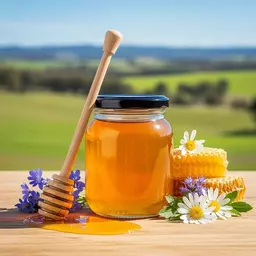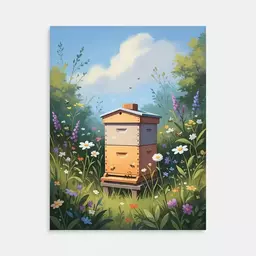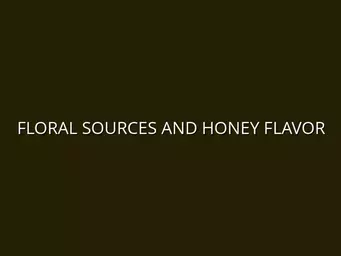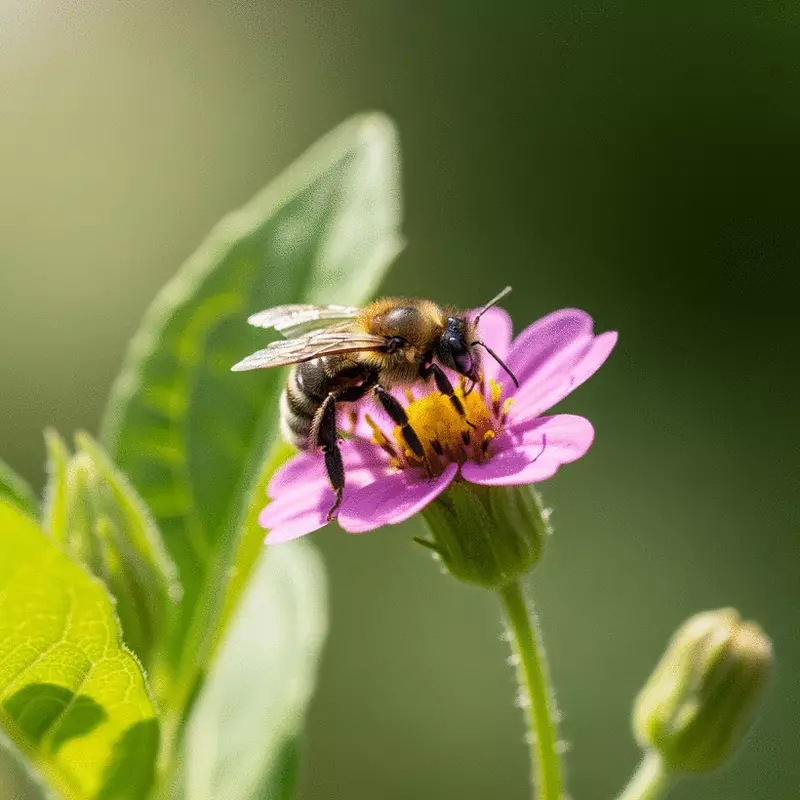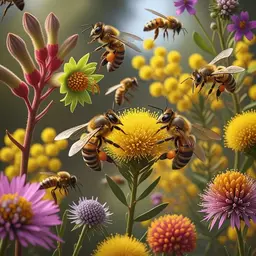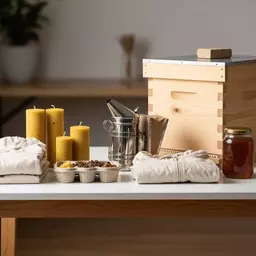Native Plants for Backyard Bees

What if your backyard could become a sanctuary for honey bees, playing a crucial role in their survival? By choosing native plants, you can create a thriving environment not just for these vital pollinators, but for the entire ecosystem.
What You Will Learn
- Native plants provide essential nectar and pollen, fostering healthy honey bee populations.
- Choosing the right plants, such as wildflowers and herbs, can significantly attract and sustain bees.
- Plant diversity supports not only honey bees but also a variety of other beneficial insects and wildlife.
- Creating habitats that promote biodiversity enhances ecosystem resilience to climate change and pests.
The Pillars of a Bee-Friendly Garden
Understanding what makes a plant appealing to honey bees is crucial for supporting their populations. Focus on these key elements. For those just starting their journey into beekeeping, a beginner's guide to honey bees can provide foundational knowledge on their needs and behaviors.
High Nectar & Pollen Production
Bees require abundant, nutrient-rich nectar for energy and pollen for protein, ensuring hive health and honey production.
Accessible Flower Structures
Open flowers and simple shapes allow bees easy access to the vital reproductive parts of the plant.
Specific Color Preferences
Bees are particularly attracted to shades of blue, purple, and yellow, which stand out against green foliage.
Seasonal Bloom Diversity
A variety of plants blooming throughout the year ensures a continuous food supply for bees across seasons.
Creating a Buzz: Why Native Plants Matter for Honey Bees
As I stroll through my garden, I’m often reminded of how native plants serve as vital allies for our honey bee populations. These plants are not just beautiful additions to our landscapes; they play a significant role in supporting the health and sustainability of our ecosystems. Native plants are adapted to local conditions, making them easier to grow and better suited to provide the nectar and pollen that honey bees rely on.

By choosing native flora, we can create environments that not only attract honey bees but also support their long-term survival. The decline in bee populations is a pressing issue, and as beekeepers and environmental advocates, we have the power to make a difference right in our own backyards!
The Role of Native Plants in Supporting Honey Bee Populations
Native plants are crucial for honey bees because they offer a reliable food source throughout the growing season. Unlike non-native plants, which may not provide the right nutrients, native plants are rich in nectar and pollen, essential for bee health. This abundance helps maintain stable populations and encourages successful pollination of fruits and vegetables in our gardens and farms. To further ensure a thriving bee habitat, understanding the seasonal flower guide for bees is highly beneficial.
- Adaptation to Local Climate: Native plants thrive in local conditions, reducing the need for chemical fertilizers and pesticides.
- Seasonal Food Sources: They bloom at different times of the year, ensuring bees have access to food across seasons.
- Support for Local Wildlife: Native plants also provide habitats for other beneficial insects and wildlife.
By incorporating native plants into our landscapes, we contribute to the preservation of biodiversity and enhance the health of our local ecosystems. It’s a win-win for both bees and gardeners!
Understanding Honey Bees’ Needs: What Makes a Plant Bee-Friendly?
When selecting plants for your garden, it’s essential to consider what makes a plant truly bee-friendly. Honey bees are attracted to plants that produce abundant nectar, have open flower structures, and are rich in color. For instance, blooms in shades of blue, purple, and yellow are particularly appealing to these buzzing pollinators.
- High Nectar Production: Look for species known for high nectar yield.
- Flower Structure: Open flowers allow bees easy access to nectar and pollen.
- Aromatic Qualities: Fragrant plants can lure bees from afar.
By choosing plants that meet these criteria, we can create a welcoming environment for honey bees, encouraging them to visit and thrive. As a beekeeper, I’ve seen firsthand how these small choices can lead to significant impacts on local bee populations.
Key Nectar and Pollen Sources for Honey Bees
Identifying the right plants is key to nurturing our honey bees. Here are some top nectar and pollen sources that I’ve found to be especially beneficial in my own garden:
- Wildflowers: A diverse mix can provide bees with a variety of nutrients.
- Herbs: Plants like lavender, thyme, and rosemary are not only great for cooking but also attract bees!
- Fruit Trees: Blossoms from apple, cherry, and peach trees are favorites among honey bees.
- Sunflowers: These tall beauties are like candy for bees, offering both nectar and pollen.
By including these plants in your garden, you can help ensure that honey bees have the resources they need to thrive. Each bloom is a step towards a healthier ecosystem, and together, we can make a significant impact!
Interactive Poll: Your Thoughts on Native Plants!
How do you feel about incorporating native plants in your garden to support honey bees? Choose an option below:
Building a Sustainable Ecosystem: The Ecological Benefits of Native Plants
At Nectar Network, we believe that native plants are the unsung heroes of our ecosystems! Not only do they support honey bees, but they also foster a vibrant and diverse environment for countless species. When we cultivate native plants in our backyards, we are actively participating in a much larger mission of supporting biodiversity. Let's explore the incredible ecological benefits of these plants and how they contribute to a healthier planet.
By choosing to plant native species, we create habitats that sustain local wildlife. These plants have evolved to thrive in specific regions, providing food and shelter for various insects, birds, and other animals. They are often better suited to our local climates and soils, which means they require less water and fewer resources compared to non-native species. This is especially important as we strive to minimize our environmental impact!

The Importance of Supporting Biodiversity in Your Backyard
Supporting biodiversity starts right in your backyard! By planting native species, we can boost the populations of local honey bees and other beneficial insects. Here are some key reasons why this is so important:
- Pollinator Health: Native plants provide essential pollen and nectar sources, crucial for the survival of honey bees and other pollinators.
- Food Web Stability: A diverse plant community supports various insects, which in turn feeds birds and other wildlife, creating a balanced ecosystem.
- Resilience to Changes: Biodiverse environments are more resilient to climate change and pest pressures, helping to ensure ecosystem health over time.
As I look out at my own garden, I see how these principles come to life! By nurturing a variety of native plants, I’ve attracted not just bees, but butterflies and birds, creating a lively and interconnected habitat.
Creating Habitat for Beneficial Insects Beyond Honey Bees
While honey bees are vital, they are just one piece of the pollinator puzzle. By planting native flora, you’ll also support a whole host of beneficial insects, like ladybugs, lacewings, and hoverflies. These insects play essential roles in pest control and pollination.
Here are some strategies to create habitats for these valuable creatures:
- **Layer Your Plants:** Use a mix of flowering plants, shrubs, and trees to provide different levels of habitat.
- **Avoid Pesticides:** Opt for organic gardening practices to protect beneficial insects from harmful chemicals.
- **Leave Some Dead Wood:** Dead trees or logs can serve as homes for many insects and other wildlife.
It’s exciting to see how even small changes in our gardens can lead to big impacts on the local ecosystem! Each plant contributes to a thriving community that works together to support life.
Fostering Floral Diversity to Strengthen Ecosystem Health
Floral diversity is key to a robust ecosystem. By planting a variety of native species, you create a buffet of food options for pollinators and other wildlife. This diversity not only supports bees but also ensures that various species can thrive and adapt to environmental changes. For those interested in expanding their knowledge beyond honey bees, exploring native bees explained can offer insights into other crucial pollinators.
Consider incorporating these plant families in your garden:
- Asters: Great for late-season nectar!
- Goldenrods: Perfect for attracting a variety of pollinators.
- Milkweeds: Essential for monarch butterflies and also beneficial to bees.
As you plan your garden, think about how you can combine these plants for a vibrant, varied landscape that supports all kinds of wildlife. Each flower contributes to a healthier ecosystem, which is what we’re all about at Nectar Network!
Frequently Asked Questions About Native Plants and Honey Bees
- Q: Why are native plants better for honey bees than non-native plants?
- A: Native plants are adapted to local conditions and provide the specific nutrient-rich nectar and pollen that local honey bee populations have evolved to thrive on. They also often require less water and fewer pesticides, creating a healthier environment for bees.
- Q: What types of native plants are most attractive to honey bees?
- A: Honey bees are particularly attracted to native wildflowers, herbs like lavender and thyme, fruit tree blossoms, and sunflowers. They prefer blooms in shades of blue, purple, and yellow with open structures that allow easy access to nectar and pollen.
- Q: How does plant diversity help honey bees?
- A: Plant diversity ensures a continuous food supply throughout the growing season, as different plants bloom at different times. This variety also provides a wider range of nutrients, contributing to healthier and more resilient bee populations.
- Q: Can creating a bee-friendly garden help with the decline of bee populations?
- A: Absolutely! By providing reliable food sources and safe habitats, gardeners can significantly contribute to the health and sustainability of local honey bee populations. Every bee-friendly garden adds to a larger network of support for pollinators.
- Q: Besides honey bees, what other beneficial insects do native plants attract?
- A: Native plants attract a wide array of beneficial insects, including ladybugs, lacewings, hoverflies, and various species of butterflies and other native bees. These insects play crucial roles in pollination and natural pest control, enhancing overall ecosystem health.
Recap of Key Points
Here is a quick recap of the important points discussed in the article:
- Native plants provide essential nectar and pollen sources, supporting honey bee health and pollination.
- Choosing a variety of native species ensures food availability throughout the growing season.
- Bee-friendly plants have high nectar production, open flower structures, and aromatic qualities.
- Incorporating diverse plant families promotes ecological stability and resilience in local ecosystems.
- Avoiding pesticides and providing habitats for beneficial insects enhances pollinator environments.
